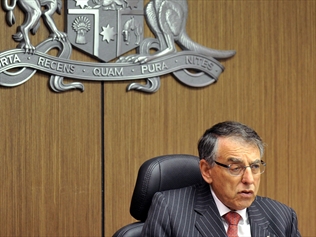
Inspector Clouseau can be proud of the NSW Independent Commission Against Corruption. Under the leadership of former Commissioner David Ipp, this agency conducted an inquiry into the grant of a coal exploration licence at Doyles Creek that is right out of Clouseau’s playbook.
Evidence of critical importance was simply overlooked. The process of awarding that licence, known as EL7270, was the subject of an inquiry that ran for weeks yet ICAC still missed the fact that no coal deposit had changed hands in the awarding of the licence in 2008.
That’s an extraordinary failure. It means ICAC was unaware that no value changed hands when EL7270 was awarded. This raises doubts not just about the rigour of ICAC’s findings but about the NSW government’s justification for cancelling that licence after it had been acquired by NuCoal Resources, a public company.
Clouseau of course was famous for asking “Where’s the body?” – even at an art robbery. A good empirical question nonetheless.
In NuCoal’s case, in question was the existence of a body of commercially valuable coal that ICAC charged had been handed to Doyles Creek as a gift in payment of a favour — a bribe if you like.
Between whom? We’ll fill you in at the other end but first lets look for a valuable coal deposit?
Like Clouseau, we turn to the forensic team. Meet Dr Ian Stone, leading Hunter Valley coal geology expert and the man who supervised the drilling of the Doyles Creek exploration licence right from the instant of its grant seven years back on December 15, 2008.
Assisting him was John Pala, his then partner in consulting firm Palaris, an experienced mining engineer with the exact knowledge of what makes a coal deposit mineable and hence valuable.
So first, clues: When Stone assumes the job, there are just four drill holes in 28 square kilometres of the gently rolling and slightly backwatered country of Jerrys Plains in the central Hunter.
Drilled in the 1980s and 1990s these holes did hit coal but it was shot with “intrusives”, igneous dykes and sills that preferentially find and burn out coal seams rendering them commercially worthless.
Another clue: the area had not been applied for by anyone for years, even though it is adjoined by major mines like Peabody’s Wambo and Anglo American’s Drayton. It doesn’t sound like there’s a commercially valuable body of coal here, does it?
Even had the four holes all been good, their spacing was so sparse that it is impossible to “join the dots” and responsibly correlate which coal is running where hundreds of metres below surface.
Stone’s work was also guided by the independent geologist who put his report in the NuCoal Prospectus, Guy Palese. Described as “a prophet wandering in the wilderness” with an adventurous theory that the intrusives were less to the south and that down in that area the district’s champion, the Whyborn Seam might not be speared and burnt out.
Based on just four holes, it was a long shot theory.
As Stone tells it: “The Whybrow seam does have a good history, it’s mined in a number of places quite productively so it was a good target. It was the high point, but in drilling [we found] igneous intrusions taking out the Whybrow”.
In that moment, a great theory went up in smoke, and still no high-value coal deposit.
“The second [NuCoal] hole was pretty close to smack in the middle of the EL. That was the hole that showed what was ahead of us. The underlying Whynot Seam had become 70 per cent thicker, there is a very significant amount at three and a half metres thick. Suddenly you had some serious potential in a previously [commercially] unknown seam that was now on the radar.”
Removing the geo-speak, an unexpected discovery had taken place when the original target seam didn’t drill out, but one of the other sundry seams below it suddenly presented thick, high-grade and so clean it was 100 per cent export coal for steel making.
Aha! So here is the first evidence of a commercially valuable coal deposit. And it was discovered by a chance — after the grant of the licence.
It is worth noting too that NuCoal purchased the Doyles Creek project 14 months after the granting of the licence.
Ipp’s ICAC did not call experts like Stone. Instead it drew witnesses like Luke Foley, now leader of the NSW opposition, and federal Labor frontbencher Anthony Albanese to discuss the relationship between the granter, then Minister Ian MacDonald, and grantee John Maitland, a former union leader.
On the back of its courageous discovery of economic coal in the Whynot Seam, NuCoal grew to an ASX-listed market capitalisation of $400 million in early 2011.
But by November 23, 2011 the NSW parliament was so rife with self-generated scuttlebutt about NuCoal that it referred the granting of EL7270 to Ipp’s ICAC.
This move would ultimately see Parliament strip the asset from NuCoal at ICAC’s recommendation making the remaining shell worth just $2m today. Death by NSW politics.
Supreme Court proceedings against Maitland and MacDonald are set down for February and March next year.
But without a commercially valuable coal deposit present in the ground at the time of grant, where was Clouseau’s “body”?
After Parliament’s shock cancellation of NuCoal’s licence with the passing of the Mining Amendment Act on January 30, 2014, minutes after its circulation to members, NuCoal’s world collapsed.
Palaris stood down 20 people, drilling firm Howarth Drilling a further 20 before it went to the wall and to add insult, NuCoal’s was ordered to give its $25m in drill core data and reports outlining its discovery to the state, as a gift.
Several high-profile careers were destroyed, 3,400 shareholders lost their money, and NSW’s reputation as a trustworthy jurisdiction was shot.
Julian Malnic is chairman of the Sydney Mining Club and is researching a book for NuCoal Resources about the 2014 expropriation of its Doyles Creek coal project.
(WTF) Used with permission.

Great Story! Some interesting observations regarding this clown.
1. He actually looks like the Peter Sellers character, the bumbling Clouseau!
2. Amazingly, he was a “Judge” in the WA supreme court!
3. He was promoted by another South African in WA, one may say a “mate”!
4. “Whites” like Ipp who fled the Anti-Aparthied movement in South Africa were dubbed PFP’s (Packed for Perth’s) by the ANC